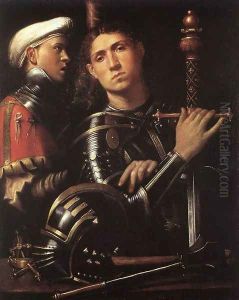Paolo Cavazzola Paintings
Paolo Cavazzola, born Paolo Morando in 1486 in Verona, Italy, was an Italian painter who played a significant role in the transition between the High Renaissance and Mannerist styles of painting. Although not as widely recognized as some of his contemporaries, Cavazzola's work is notable for its innovative approach to color and composition, which had a profound influence on the development of Venetian painting in the early 16th century. His early education and influences in art remain somewhat obscure, but it is believed that he was initially trained by local artists in Verona, possibly coming into contact with the works of early Renaissance masters, which would shape his developing style.
Cavazzola's career was relatively short-lived, as he died young at the age of 36 in 1522, yet his oeuvre demonstrates a remarkable evolution in style and technique. Early in his career, his works exhibited the clear, balanced compositions and precise treatment of detail characteristic of the High Renaissance. However, as his style evolved, Cavazzola began to experiment with more dynamic compositions and a richer, more expressive use of color, elements that anticipated the Mannerist movement. His paintings often depicted religious themes, a common subject matter for the time, but he approached these traditional scenes with a fresh perspective, imbuing his figures with a sense of emotion and humanity that was ahead of his time.
One of Cavazzola's most notable contributions to the art world was his ability to blend the influences of his Veronese roots with the innovative techniques and styles emerging from Venice, where the use of color and light was beginning to transform painting in new and exciting ways. This blend of influences is evident in works such as his 'Madonna and Child with Saints', which showcases his skill in using color to create depth and emotion, setting the stage for the later developments in Venetian painting.
Despite his untimely death, Cavazzola's work had a lasting impact on the art world, particularly in Verona and Venice, where he inspired a generation of artists who would go on to fully develop the Mannerist style. His legacy is preserved in several of his works that survive today, offering a glimpse into the transitional period of Italian Renaissance art and the early seeds of Mannerism. Cavazzola remains a figure of interest for art historians and enthusiasts alike, who appreciate his role in shaping the trajectory of Italian art during a pivotal moment in its history.
